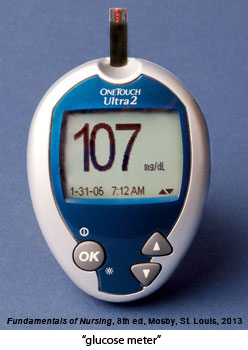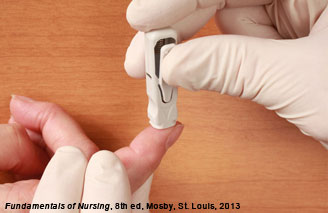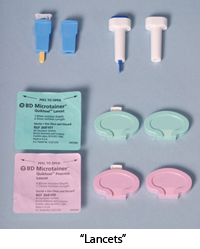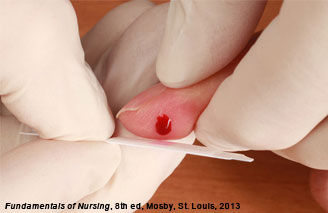What to Do
Selecting a Blood Glucose Meter

The types of meters available for checking blood glucose change almost daily. A person with diabetes should work closely with their doctor or nurse to decide on the best meter for them. A medical equipment company can also be helpful in the choice of a glucose meter.
A glucose meter is a small machine that works with one or more lithium or AAA battery. Some meters are rechargeable. The meter reads the reaction of blood mixed with chemicals on a test strip. A number comes up on a small screen to show the blood glucose level.
Meters have a variety of features:- Size of the meter
Meters can be as small as a pen or credit card, but most fit easily in the palm of a hand. Smaller meters have small display screens that might make it hard to read numbers. - Timing
Most meters give a test result in 3 to 30 seconds. - Cost of meter and strips
 Medicare covers all meters and strips equally. Commercial insurance often have “preferred meter systems”. Using the preferred meter gives the person the best pricing.
Medicare covers all meters and strips equally. Commercial insurance often have “preferred meter systems”. Using the preferred meter gives the person the best pricing. - Size and color of display screens
People who have trouble seeing or who are color blind should select a meter they can easily read. - Voice readouts
- Memories to display multiple readings
- Graphics to display readings on a computer
- Dual meters that measure blood glucose and blood pressure

Using a Lancet or Lancing Device
Every blood glucose meter comes with a lancing device and lancets. A lancet is a very short, sharp tipped metal cutting device. It is used to puncture the skin and produce a blood drop. Lancets vary by the diameter or width, and by the length of the metal. A lancing device (see photo) is a spring loaded instrument. You place a new lancet into the device with each use. When you trigger the lancing device, it delivers the lancet at the same depth each time you prick the skin. Certain lancing devices will only use lancets that fit that model.Lancets come in different sizes (see photo). Smaller diameter lancets and sharper lancets hurt the least and enter the skin most easily. Lancing devices usually can be adjusted to alter the depth that the lancet goes into the skin. The purpose is to obtain a small amount of blood for testing with the least discomfort.

Testing Meters and Test Strips
Many meters come with a bottle of control solution. The control solution contains glucose. It allows you to check the meter when you open a new box of test strips and any time you question the accuracy of the meter. Follow the manufacturer’s directions for proper set-up. Always check the expiration date when opening the control solution. For example, many solutions need to be discarded 1 month after opening. If you need more control solution, the manufacturer will usually provide a new bottle if you call the 1-800 number on the package.
Prevent Infection
When you stick the skin for a drop of blood, the break in the skin causes a chance of a skin infection. An infection does not happen often. Be cautious:
- Have the person wash their hands with warm water thoroughly (15 seconds) before you do a finger stick.
- Wash your hands thoroughly (15 seconds) or use a hand disinfectant.
- Do not reuse a lancet.
- Clean the glucose meter regularly (refer to the glucose meter operating manual).
- Do not share a meter with someone else in the family.
How to Get Correct Readings from a Meter
Take these steps to be sure that the glucose meter test results are accurate:- Make sure that the antiseptic has dried on the skin before you stick the skin with the lancet.
- Always have a good “hanging” drop of blood to apply to the test strip.
- Make sure that the test strip is fully inserted into the meter.
- If the lancet did not pierce the skin at the correct depth, do not squeeze the finger with excessive force to get the drop of blood. Instead, start again with a new site/different finger.
- To avoid damage to the meter, never leave diabetic equipment/supplies in the car on hot or cold days.
- Never allow your finger or any other surface to touch the testing pad on the testing strip.
- Do not try to take a blood sample from an area of the skin you stuck the last time you measured the blood glucose.
- Never bend or cut the test strips. Do not reuse them.
Storage of Meter and Test Strips
- Store the meter and test strips together in a cool dry area. For example, store in a plastic container that you can seal, in the bedroom.
- Always keep the test strips in the original closed vial.
- Keeping test strips in direct light and humidity may make them unstable.
- Do not refrigerate the test strips and do not use them after their expiration date. Check each meter's operating manual for the specifics about storage of the meter and test strips.
Giving Insulin Injections
If the person you care for becomes ill and is unable to give themselves their insulin, you need to know how to give a shot or injection. See our video on Giving a Subcutaneous Injection.
Giving Glucagon
Glucagon is a medicine that raises blood sugar. You give it in the form of a shot when a person’s blood glucose level gets so low (hypoglycemia) that he or she passes out or cannot swallow or eat sugar or sugar-sweetened products. This often occurs when the person has taken too much insulin.
Test the person’s blood sugar before giving glucagon, if possible. The medicine is safe and there is no danger of taking too much. But, it only should be given in an emergency.
See our lesson on Giving a Subcutaneous Injection – to know how to give glucagon.
Accidental Needle Stick
A dirty lancet can carry infection. You are at risk if you accidentally cut yourself with the lancet or if you touch a cut or open sore on your body with the lancet. You can get any number of different infections, such as Hepatitis or AIDS if you do not handle medical waste the right way. See our video on Medical Waste.
- If you accidentally stick yourself on a dirty needle or lancet, immediately wash the injured area with soap and water. Rinse thoroughly.
- Call your doctor as soon as possible to inform him or her about the needle stick.
- If you provide care for a person routinely, you might want to be vaccinated for Hepatitis B.
- Dispose of dirty lancets in special plastic sharps containers or in a hard plastic container, like a soda bottle or large liquid detergent bottle. Since the containers are not recyclable, you may be able to dispose of them in the trash. Check with the trash company to know how to dispose of a container. Some hospitals and pharmacies have sharps disposal programs. Many waste management companies allow you to mail the containers for disposal.